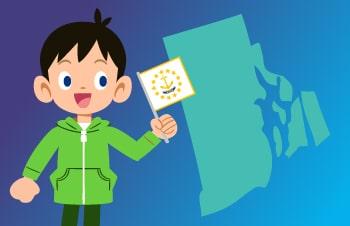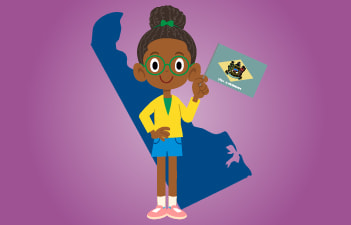As one of the original 13 colonies, South Carolina is a state rich with history. For example, did you know that the first battle of the Civil War took place in this state? Or that Charleston is the oldest city, founded in 1670?
As part of Time4Learning’s full series of United States unit study supplements, your students can learn about this southeastern state through fun, educational activities, facts, and field trip ideas. You can also download our list of PreK-12 interactive activities that align with your study of interesting facts about South Carolina.
South Carolina Fast Facts
| Became a State | May 23, 1788 |
|---|---|
| Order it Joined the Union | 8th state |
| State Capital | Columbia |
| State Abbreviation | SC |
| Border States |
|
| State Flag |  |
| State Flower | Yellow Jessamine (Jasmine) |
| State Song | “Carolina” |
| State Nicknames |
|
| Notable South Carolinians |
|
Historical Facts About South Carolina
During the precolonial period, South Carolina was home to various Native American tribes. The Cherokee and the Catawba were the largest tribes, but smaller ones like the Edisto, Chicora, and Pee Dee lived in the area too. After the arrival of Spanish explorers in the 1520s, many Native Americans were displaced or died from diseases.
South Carolina is named in honor of King Charles I of England (Carolus in Latin). He established the Province of Carolina in 1629 in the area that now makes up North Carolina, Georgia, and Tennessee. A few decades later, settlers arrived from all over Europe and African slaves did all the labor. By 1720, slaves made up the majority of the population. After the invention of the cotton gin in 1794, cotton became an important crop, employing the majority of slave labor.
During the presidential campaign of 1860, Abraham Lincoln voiced his opposition on the expansion of slavery and ideas to abolish the system. Many in the South were making plans to leave, or secede the Union if he were to get elected. After Lincoln won the presidential election, South Carolina became the first state to secede the Union on December 20, 1860. Alabama, Florida, Georgia, Louisiana, Mississippi, and Texas soon followed suit. These seven states would make up the Confederate States of America.
The following year, the Confederate States Army attacked Fort Sumter in Charleston, marking the start of the American Civil War. Later that year, the Union occupied Beaufort County and surrounding areas, serving as a base for the remainder of the war. Despite this, South Carolina was not a major battleground, however, the state’s economy and many plantations were devastated by the end of the war in 1865.
The Reconstruction era followed, however, it was marked by corruption and disenfranchisement of several groups. Once the 20th century came around, thousands of African Americans left the state for better opportunities in the north. After World War I, the price of cotton dropped and half the crop was destroyed in 1922 due to the boll weevil, a destructive insect, that feeds on the cotton.
Here are some more interesting facts about South Carolina’s history that your homeschooler may like:
- South Carolina was one of the original 13 colonies.
- In March 1780, during the Revolutionary War, the Siege of Charleston took place. Six weeks later, American forces surrendered to the British, resulting in one of the worst American defeats of the war.
- President George Washington visited South Carolina in 1791 during his Southern Tour, the only visit ever to the states south of Virginia.
- The first battle of the Civil War took place at Fort Sumter in 1861.
- South Carolina was the first state to ratify the Articles of Confederation in 1778.
- Union soldiers burned and destroyed most of Columbia in 1865.
- On June 28, 1776 during the Battle of Sullivan’s Island, cannonballs bounced off the Palmetto logs use on the exterior wall of the fort.
- In 1886, an earthquake killed more than 100 people and caused over five million dollars in damage.
- In 1958, an 8,500 pound nuclear bomb was accidentally dropped from an Air Force jet creating a crater 75 feet wide and between 25-35 feet deep. Fortunately, the bomb was not armed with the trigger and no one was killed.
- Althea Gibson, a tennis player from South Carolina, was the first person of color to win a Grand Slam title.
Bring history and geography to life with Time4Learning’s interactive online social studies curriculum for grades 2-12.
Geographical Facts About South Carolina
South Carolina is on the southeastern portion of the United States. It is bordered on the north by North Carolina and in the south by Georgia. With just over 32,000 square miles, South Carolina is ranked 40th in the country with regards to size. The state is made up of 46 counties, and has over 180 miles of coastline that include popular tourist destinations like Myrtle Beach and Hilton Head Island.
Ask your child if they can locate South Carolina on this unlabeled U.S. map? Then, use this map of the state to give your student an idea of where major cities are located. Below are several interesting facts about South Carolina and its geographical features.
- The capital city, Columbia is located at the center of the state.
- Charleston, the oldest city in South Carolina, is located on the east about halfway south from the border with North Carolina.
- In 2017, the population of South Carolina was over 5 million, ranking it 23rd in population.
- South Carolina is divided into four areas: the Sea Islands, Atlantic Coastal Plain, Piedmont Plateau, and Blue Ridge Mountains.
- The highest point is Sassafras Mountain, located on the northwest near the North Carolina border. It is 3,560 feet above sea level.
- The largest city is Charleston with a population of over 134,000 (2016); the smallest town is Smyrna, with an estimated population of 50 (2016).
- Major rivers include the Edisto, Great Pee Dee, Santee, and Savannah.
- The largest lake is Lake Marion at 172 square miles (110, 600 acres).
- Raven Cliff Falls is the highest waterfall at 400 feet.
- The Blue Ridge Mountains run through the northwestern portion of the state.
- A 135 foot tall water tower in the shape of a peach is located in Gaffney. The tower holds one million gallons of water.
- The geographic center of South Carolina is in Richland County.
- The Lowcountry is an area along the coast that is known for its history, culture, and natural areas.
South Carolina State Map
Download our FREE South Carolina state map printable. Use it as a coloring page or use it to plot the state’s geographical features.
Activities for Children in South Carolina
Do you homeschool in the state of South Carolina? There are so many fun and educational destinations to explore that can enrich your homeschool. Whether you’re looking to get outdoors and get some exercise, learn about the state’s history, or take in the arts, there is something for everyone to enjoy.
If you are visiting South Carolina, or call it home, below is a list of field trip ideas that will help supplement the South Carolina facts unit study.
- Patriots Point (Mount Pleasant) – This naval and maritime museum is home to the USS Yorktown where visitors can go inside the aircraft carrier and even take part in sleepovers. A number of educational programs are also available for students.
- Riverbanks Zoo (Columbia) – This 170-acre zoo is home to more than 2,000 animals and also features an aquarium and botanical garden. The zoo offers a few homeschool programs, day camps, and behind-the-scenes tours.
- South Carolina Aquarium (Charleston) – At approximately 93,000 square feet, the aquarium is home to thousands of animals including sharks, loggerhead turtles, and alligators. Families can also sign up for the Homeschool Explorers Club.
- Charleston Museum (Charleston) – Established in 1773, the museum’s exhibits include a natural history gallery, lowcountry history hall, an armory, and more. The museum also hosts homeschool history days, workshops, and scout programs.
- Sesquicentennial State Park (Columbia) – Known to locals as ‘Sesqui’, the name means 150th. It was donated to Columbia on the city’s 150th birthday in 1937 by the Civilian Conservation Corps. Visitors to the 1,400 acre park can hike, bike, kayak, enjoy a picnic or cool off in the splash pad.
South Carolina Freebies and Deals for Homeschoolers
- Angel Oak Tree Park (Charleston) – This historical landmark in St. Johns Island is home to an oak tree believed to be between 400-500 years old, although some think it may be older. The tree stands over 66 feet tall and has survived hurricanes, floods, and earthquakes.
- Greenville County Museum of Art (Greenville) – Visitors enjoy free admission at this art museum that focuses on American art from such artists as Andrew Wyeth, Jasper Johns, and more.
- Old Sheldon Ruins (Yemassee) – This historic site in Beaufort County is surrounded by oak trees and grave sites. Visitors can go into the building that was originally known as Prince William’s Parish Church, take photos of the grounds, or even do gravestone rubbings.
- Confederate Relic Room & Military Museum (Columbia) – The second Friday of each month during the school year, the museum hosts Homeschool Fridays, a free program for students of all ages that includes lectures, activities, and more.
- South Carolina State Museum (Columbia) – The museum features Homeschool Thursdays, which is free for all South Carolina homeschoolers with proper documentation and picture ID. The program includes lessons for students of various ages and grades.








